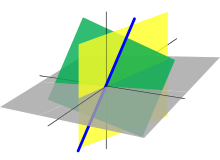Plane of origin
An original plane is in mathematics a level that the origin contains. The three coordinate planes in a Cartesian coordinate system are important original planes . Planes of origin have particularly compact representations as plane equations and are characterized by comparatively simple formulas for calculating intersections and distances . The set of vectors which lie in an original plane forms a two-dimensional sub - vector space of the three-dimensional Euclidean space .
definition
In the analytical geometry one is plane as a subset of the points of the three-dimensional space considered, each point by its coordinates is presented. An original plane is now characterized by the fact that it runs through the coordinate origin of the selected Cartesian coordinate system . An original plane is then expressed in coordinate form by the plane equation
where and are real parameters that cannot all be zero.
Vector illustration
Planes of origin can also be represented by vector equations, with each point of the plane being represented by its position vector . In parametric form , an origin plane is then given by the equation
- With
where and are two linearly independent vectors of the plane. An origin plane thus consists of those points whose position vectors can be written as a linear combination of two given vectors. In normal form , a plane of origin is given by the normal equation
characterized, where is a normal vector of the plane and represents the scalar product of the two vectors and . An original plane thus consists of those points whose position vectors are perpendicular to a given vector. If an original plane is given in parametric form, a normal vector of the plane can be calculated using the cross product .
Examples
The three coordinate planes are important examples of original planes
- or or
- or or
- or or
Where , and are the three unit vectors .
properties
cut
The intersection of two different planes of origin always results in a straight line through the origin , i.e. a straight line with the straight line equation
- with ,
where is a direction vector of the straight line . If the two original planes have the normal vectors and , then a direction vector of the line of intersection results as the cross product
of the two normal vectors. The intersection of three planes of origin gives the coordinate origin if and only if their normal vectors are linearly independent . Three vectors in space are linearly independent if and only if they are not in the same plane of origin.
Distance of a point
The distance between a point with a position vector and an origin plane with a normal vector is
- ,
where is the length ( Euclidean norm ) of . This distance corresponds to the length of the vertical line between the point and the plane. The position vector of the plumb line is then the orthogonal projection of onto the plane of origin and thus through
given.
Reflection of a point
The reflection of a point with a position vector at an original plane is obtained by doubling the perpendicular vector from the point to the plane. The vector of a vector mirrored with respect to a plane of origin is thus through
given, where again is a normal vector of the plane.
Vector space structure
The set of vectors of three-dimensional space forms a vector space , Euclidean space . The set of vectors that lie in a plane of origin forms a sub-vector space of Euclidean space
- .
This sub-vector space is precisely the linear envelope of the two vectors spanning the plane of origin and , or the orthogonal space of the linear envelope of a normal vector of the plane. The original planes are the only two-dimensional sub - vector spaces of Euclidean space.
For every plane that does not contain the origin, there is exactly one parallel origin plane . Each level can thus be used as an affine subspace of the Euclidean space of form
where the position vector of a point is from .
Generalizations
More generally, levels can also be viewed in higher-dimensional spaces. An origin plane is then a two-dimensional subspace of the . In parametric form, such a plane of origin is through as in three dimensions
- With
given, where two are linearly independent vectors. The corresponding normal form
However, with no longer defines a plane, but a hyperplane of the dimension that contains the origin.
See also
literature
- Kenneth Eriksson, Donald Estep, Claes Johnson: Applied Mathematics: Body and Soul 1 . Springer, 2006, ISBN 3-540-35006-3 .
- Mike Scherfner, Torsten Volland: Mathematics for the first semester . Springer, 2012, ISBN 3-8274-2505-0 .


















































